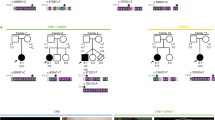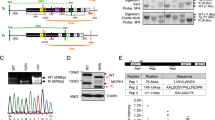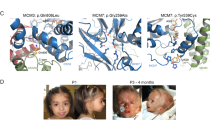Abstract
Meckel syndrome (MKS) is a severe fetal developmental disorder reported in most populations. The clinical hallmarks are occipital meningoencephalocele, cystic kidney dysplasia, fibrotic changes of the liver and polydactyly. Here we report the identification of a gene, MKS1, mutated in MKS families linked to 17q. Mks1 expression in mouse embryos, as determined by in situ hybridization, agrees well with the tissue phenotype of MKS. Comparative genomics and proteomics data implicate MKS1 in ciliary functions.
This is a preview of subscription content, access via your institution
Access options
Subscribe to this journal
Receive 12 print issues and online access
$209.00 per year
only $17.42 per issue
Buy this article
- Purchase on Springer Link
- Instant access to full article PDF
Prices may be subject to local taxes which are calculated during checkout

Similar content being viewed by others
References
Paavola, P., Salonen, R., Weissenbach, J. & Peltonen, L. The locus for Meckel syndrome with multiple congenital anomalies maps to chromosome 17q21-q24. Nat. Genet. 11, 213–215 (1995).
Roume, J. et al. A gene for Meckel syndrome maps to chromosome 11q13. Am. J. Hum. Genet. 63, 1095–1101 (1998).
Morgan, N.V. et al. A novel locus for Meckel-Gruber syndrome, MKS3, maps to chromosome 8q24. Hum. Genet. 111, 456–461 (2002).
Hentges, K.E., Kyttala, M., Justice, M.J. & Peltonen, L. Comparative physical maps of the human and mouse Meckel syndrome critical regions. Mamm. Genome 15, 252–264 (2004).
Swoboda, P., Adler, H.T. & Thomas, J.H. The RFX-type transcription factor DAF-19 regulates sensory neuron cilium formation in C. elegans. Mol. Cell 5, 411–421 (2000).
Efimenko, E. et al. Analysis of xbx genes in C. elegans. Development 132, 1923–1934 (2005).
Li, J.B. et al. Comparative genomics identifies a flagellar and basal body proteome that includes the BBS5 human disease gene. Cell 117, 541–552 (2004).
Keller, L.C., Romijn, E.P., Zamora, I., Yates, J.R. III & Marshall, W.F. Proteomic analysis of isolated chlamydomonas centrioles reveals orthologs of ciliary-disease genes. Curr. Biol. 15, 1090–1098 (2005).
Kramer-Zucker, A.G. et al. Cilia-driven fluid flow in the zebrafish pronephros, brain and Kupffer's vesicle is required for normal organogenesis. Development 132, 1907–1921 (2005).
Nauli, S.M. et al. Polycystins 1 and 2 mediate mechanosensation in the primary cilium of kidney cells. Nat. Genet. 33, 129–137 (2003).
Blacque, O.E. et al. Loss of C. elegans BBS-7 and BBS-8 protein function results in cilia defects and compromised intraflagellar transport. Genes Dev. 18, 1630–1642 (2004).
Pazour, G.J. et al. Chlamydomonas IFT88 and its mouse homologue, polycystic kidney disease gene tg737, are required for assembly of cilia and flagella. J. Cell Biol. 151, 709–718 (2000).
Supp, D.M., Witte, D.P., Potter, S.S. & Brueckner, M. Mutation of an axonemal dynein affects left-right asymmetry in inversus viscerum mice. Nature 389, 963–966 (1997).
Okada, Y. et al. Abnormal nodal flow precedes situs inversus in iv and inv mice. Mol. Cell 4, 459–468 (1999).
Salonen, R. The Meckel syndrome: clinicopathological findings in 67 patients. Am. J. Med. Genet. 18, 671–689 (1984).
Acknowledgements
We thank the families for participating in the study and thank all the scientists, clinicians and genetic counselors for their collaboration in the MKS project. The work was supported by a Finnish Cultural Foundation grant to M. Kyttälä and an Academy of Finland grant to M. Kestilä. L. Peltonen was supported by a grant from the US National Institutes of Health, a grant from the Center of Excellence in Disease Genetics (the Academy of Finland) and the Biocentrum Helsinki.
Author information
Authors and Affiliations
Corresponding author
Ethics declarations
Competing interests
The authors declare no competing financial interests.
Supplementary information
Supplementary Fig. 1
Haplotypes in Finnish MKS chromosomes, the critical chromosomal region and the genomic structure of MKS1. (PDF 205 kb)
Supplementary Fig. 2
The mutation analysis of MKS1. (PDF 217 kb)
Supplementary Fig. 3
MKS1 peptide sequence comparison between species. (PDF 380 kb)
Rights and permissions
About this article
Cite this article
Kyttälä, M., Tallila, J., Salonen, R. et al. MKS1, encoding a component of the flagellar apparatus basal body proteome, is mutated in Meckel syndrome. Nat Genet 38, 155–157 (2006). https://doi.org/10.1038/ng1714
Received:
Accepted:
Published:
Issue Date:
DOI: https://doi.org/10.1038/ng1714
This article is cited by
-
Nephronophthisis: a pathological and genetic perspective
Pediatric Nephrology (2023)
-
The ciliary Frizzled-like receptor Tmem67 regulates canonical Wnt/β-catenin signalling in the developing cerebellum via Hoxb5
Scientific Reports (2019)
-
Enhanced diagnostic yield in Meckel-Gruber and Joubert syndrome through exome sequencing supplemented with split-read mapping
BMC Medical Genetics (2016)



